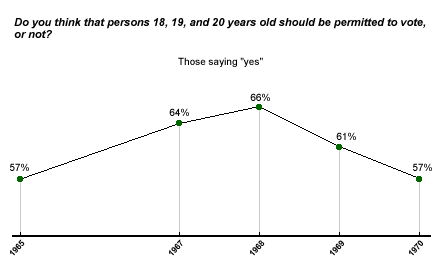Memories of the 2000 presidential election -- the closest in American history -- are still vivid in the minds of political strategists as they court voters in this year's race for the White House. With many polarizing issues before the electorate, the youngest voters, large numbers of whom are political independents, could swing the election. But the nation's youngest voters weren't always as young as they are today. Just 33 years ago, on July 5, 1971, President Richard Nixon certified the 26th Amendment, which lowered the voting age from 21 to 18.
"Father of the 26th Amendment"
West Virginia Sen. Jennings Randolph first proposed legislation to amend the Constitution to lower the voting age in 1942, during World War II. Central to the issue of granting the vote to 18-20-year-olds was the question: If they are old enough to fight and die for our country, are they also old enough to participate in the voting process? During that year, Gallup asked, "Would you favor changing the law to allow men and women, 18, 19, and 20 years old, to vote?" Only 39% of Americans said "yes," 52% said "no," and 9% had no opinion.
Randolph, often referred to as the "Father of the 26th Amendment," would introduce the bill 11 times between 1942 and 1971. Gallup polling from that period shows that Americans steadily warmed to the idea. A May 1953 poll showed, for the first time, a majority of Americans in favor of allowing 18- to 20-year-olds the right to vote. Gallup continued to show majority support for lowering the voting age in the 1950s and 1960s using a variety of question wordings. By 1968, two in three Americans said that "persons 18, 19, and 20 years old should be permitted to vote." That level of support subsided somewhat in later years leading up to the ratification of the amendment, but still remained above the majority level.
This decline in support may be a function of the social and political upheavals of the late 1960s. Among other issues, there was a growing division between younger and older Americans fueled by violent antiwar protests over the Vietnam conflict. (See "Gallup Brain: War and Peace Protests" in Related Items.)

OK, Now Where Should College Students Vote?
Soon after the amendment was passed, another issue arose -- should college students vote where they attend school, or in their hometowns? College and university towns were especially concerned about this question, because voting students could potentially have a large political impact on places where they were not permanent residents.
In July 1971, a few weeks after Nixon certified the 26th Amendment, Gallup asked, "Do you think college students should vote in the community where they attend college, or should they vote in the community where they come from?" The majority of Americans (67%) said they should vote at home, 23% said at college, and 10% had no opinion. The Supreme Court ruled in 1972 that college students should be allowed to vote in either place.
Voter Registration Boom?
Newly empowered with the legal right to vote in 1971, did 18- to 20-year-olds turn out in droves to register? Apparently not. According to a Gallup trend question asked in October 1971 -- "Is your name now recorded in the registration book of the precinct or election district where you now live?" -- just 34% of this group had registered to vote by that time. Five months later, 41% of 18- to 20-year-olds had registered to vote in time for the 1972 presidential election. But that registration figure didn't change much from that point on -- in fact, according to the U.S. Census, it remained exactly the same before the 2000 election, 28 years later.
Actual voter turnout in 1972 was the highest ever recorded for young voters -- half of the 11 million potential new voters went to the polls, according to the New Jersey Public Interest Research Group. But that figure has declined steadily ever since: Census statistics indicate that only 28% of 18- to 20-year-olds voted in the 2000 election.
Bottom Line
Fast forward to election year 2004. Anticipating another close election, both political parties are busy wooing those prized young Americans. Numerous Web sites -- Rock the Vote and the New Voters Project, among others -- have sprung up to inform, register, and encourage young voters to make their voices heard at the polls this year. The mission of New Voters Project is typical of many -- "Since the strength of a democracy is measured by the participation of its citizens," their Web site proclaims, "the New Voters Project will ensure a bright future for America, activating young adults to drive the very engine of our democracy and cast their votes." Randolph would surely applaud their mission.